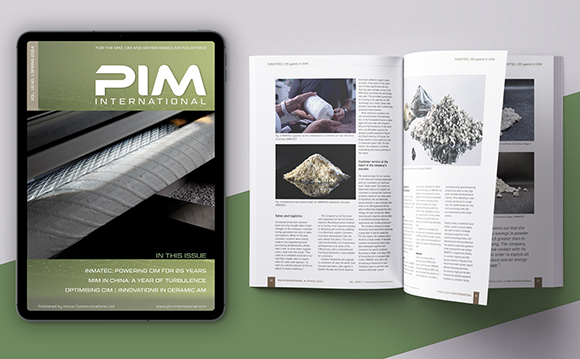The impact of COVID-19 on the global Metal Injection Moulding industry
June 11, 2020
The coronavirus (COVID-19) pandemic has had an unprecedented impact on the global economy, with few sectors left unscathed. When looking to understand the impact on MIM, the industry’s long-established regional market variations, combined with the sheer breadth of its end-use applications, appear to have prevented the downturn in from being as severe as witnessed in other industries whose fortunes are solely tied to, for example, the automotive sector.
The following report is based on communications with a number of industry professionals globally. Whilst this should be considered as no more than ‘taking the mood’ of the MIM industry, it gives some insight into the impact of the crisis as of mid-May.
Asia
The crisis has had a major impact on the Chinese economy, and China’s MIM industry is no exception. Feedback from China is mixed; however, the current and anticipated drop in global consumer spending is a far greater concern than the limited impact of the temporary shutdown. Whilst there was some disruption to production as a result of temporary closures, it is understood that the necessary production capacity is now available.
MIM components for smartphones remain the dominant market for the industry in China and it was stated that the release of Apple’s second generation iPhone SE earlier this year was a huge help to many MIM producers as, whilst this was an updated model, it used many existing parts that did not require complex approval processes. It was also suggested that whilst project planning and designs for a new generation of smartphones were completed in early 2020, production plans were delayed by “about a quarter” and are now being resumed.
The biggest concern for this application area is shrinking consumer spending. Factory shutdowns have led to a decline in personal income, leading to an unwillingness to spend on consumer electronics, the main business area for most of China’s MIM companies. Adding to this has been the closure of retail outlets for consumer electronics in many countries, all of which has led to a drop in MIM part purchase orders.
This drop in purchase orders was also seen in non-3C MIM parts, where some orders were cancelled or postponed because of end-user factory closures. At the very best, it is hoped that the crisis will be limited to a ‘lost quarter’ of production. Additionally, a further effect of the crisis has been the moving of production by some international buyers to spread supply chain risk. It was stated by one source that Taiwan has seen increasing orders for MIM parts as a result.
In Japan, most MIM companies and metal powder producers have been able to maintain their production during the crisis. This production is, however, based on orders placed before the current disruption. As a result, for many companies, production will continue at a relatively high level until August. The crunch point is expected to be September, assuming the number of new purchase orders keeps dropping.
It was stated that all companies are able to transition to full production at any time, but the recovery of the market is, of course, beyond their control. With the Japanese economy being so deeply connected to the world economy, global challenges will continue to directly impact Japanese MIM producers. In terms of specific markets, production of components for smartphones was reported to have dropped significantly, but the automotive market was shrinking by a slower rate.
With regards to MIM powder production, global supply challenges have led to short term opportunities, including, it was stated, an increased demand for Japanese powder in Taiwan because of issues relating to the purchase of Chinese powder. As with Japan’s MIM parts producers, all eyes are on September and the volume of purchase orders that will be received.
Some companies are reported to be seizing the opportunity presented by this period to progress R&D activities and investigate new technologies such as Additive Manufacturing. “It is the business strategy of each company whether to regard this difficult period as an opportunity or as a matter of course. It is a critical time when the skill of each company’s management is tested,” stated one source.
Europe
Europe’s MIM industry is, thanks to the technology’s early adoption by major European PM producers, famed for its success in the automotive sector. This has meant that many in the European MIM community have been hit by the present situation in the automotive sector.
One producer stated that its MIM facility had to halt production for a period and, now that it has restarted, it is operating at 50% of capacity and using short time working hours. Looking ahead, the firm estimated that production would be 30% down over the next three or so months and, in the longer term, down 15–20%.
The picture varies across the continent, however, and another large MIM producer stated that it was running at 100% capacity and had only stopped production for ten days, with this being made up for by working through Easter and weekends with the agreement of workers. In terms of markets, firearms was reported as the most robust. Looking ahead, this company beleives that a reduction in sales and production in the next months of 20–30% can be anticipated, subject to the start of a hoped-for recovery in September.
Just as there is no good news around automotive, two other important sectors for Europe’s MIM producers, aerospace and luxury goods, are also reported to have been severely hit. Firms that focus on these markets anticipate a drop in production of greater than 50%. “This time, the s*** has really hit the fan…” commented one producer.
North America
Just as MIM in Europe has automotive as a leading end-use market, so North America has firearms, and in such a time of crisis, firearms sales are a major driver of the domestic MIM industry. In relation to COVID-19, it was suggested that strong firearms sales are not solely driven by a desire for self-defence or ‘doomsday planning’, but also by increased hunting for food and recreation. Outside of COVID-19, in an election year the fear of new firearms legislation always drives up sales. This is reflected in the currently high stock prices of firms such as Sturm, Ruger & Company, Inc, and Smith & Wesson.
Other important US markets for MIM are medical and dental. The market for the latter, where MIM is used extensively for orthodontic brackets, has “fallen off a cliff”, stated one source, because people simply aren’t choosing to visit the dentist or orthodontist. The production of MIM surgical devices is mixed, but potentially trending down slightly. Other markets are reported as mixed, but falling slightly due to prevalent uncertainty.
On the materials supply side, one leading supplier stated that a flow of purchase orders is still coming in but noted that, “powder deliveries/lead time have moved out substantially.”
With regards to capital expenditure, one leading equipment supplier noted that, whilst it is unaware of any MIM company shutdowns, there are now some delays in facility expansions or upgrades because of regulations around building construction work.
As with other regions, the biggest challenges are anticipated in the third and fourth quarters of 2020, when some contracts have closed out and new business contracts failed to materialise during the first half of the year.
Final thoughts
As one leading global MIM firm stated, the MIM industry will follow the fate of the market segment it caters to – but, depending on how quickly the COVID-19 situation is brought under control, “the main markets could bounce back within the next eight-to-sixteen months”. This firm reported that, whilst it had been forced to reduce manpower in its facilities in order to ensure social distancing, none of its global customers had been inconvenienced.
On this point, it should be considered that highly-automated MIM facilities, making components that require little by way of manual finishing operations, will inevitably have an easier path through this crisis than firms where extensive manual finishing procedures are needed. In the MIM industry, such production exists at both extremes of the component value spectrum, be they smartphone buttons or luxury watch cases.
Finally, will the current geo-political situation have an impact on MIM? There is evidence of companies reconsidering their global supply chain strategies and the associated risks. Whether this will have a profound effect on the MIM industry remains to be seen.
Thanks to all those who contributed their insight for this news report.
















